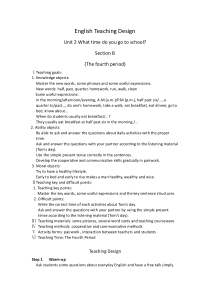 DOC
DOC
【文档说明】《Unit 2 What time do you go to school》教学设计5-七年级下册新目标英语【人教版】.docx,共(5)页,27.942 KB,由小喜鸽上传
转载请保留链接:https://www.ichengzhen.cn/view-102946.html
以下为本文档部分文字说明:
EnglishTeachingDesignUnit2Whattimedoyougotoschool?SectionB(Thefourthperiod)ⅠTeachinggoals:1.Knowledge
objects:Masterthenewwords,somephrasesandsomeusefulexpressions.Newwords:half,past,quarter,homework,run,walk,cleanSomeusefulexpres
sions:inthemorning/afternoon/evening,A.M.(a.m.)/P.M.(p.m.),halfpastsix/…,aquarterto/past…,doone’shomework,takeawalk,eatbrea
kfast,eatdinner,gotobed,knowabout…Whendostudentsusuallyeatbreakfast/…?Theyusuallyeatbreakfastathalfpastsixinthemorning./…2.Abilityobj
ects:Beabletoaskandanswerthequestionsaboutdailyactivitieswiththepropertime.Askandanswerthequestionswithyourpartneraccordingtothelisteningmaterial(T
om’sday).Usethesimplepresenttensecorrectlyinthesentences.Developthecooperativeandcommunicativeskillsgrad
uallyinpairwork.3.Moralobjects:Trytohaveahealthylifestyle.Earlytobedandearlytorisemakesamanhealthy,wealthyandwise.ⅡTeachingkeyanddiffic
ultpoints:1.Teachingkeypoints:Masterthekeywords,someusefulexpressionsandthekeysentencestructures.2.Difficultpoints:Writethecorrecttimeofeach
activitiesaboutTom’sday.Askandanswerthequestionswithyourpartnerbyusingthesimplepresenttenseaccordingtothelisteningmate
rial(Tom’sday).ⅢTeachingmaterials:somepictures,severalwordcardsandteachingcoursewareⅣTeachingmethods:cooperativeandcom
municativemethodsⅤActivityforms:pairwork,interactionbetweenteachersandstudentsⅥTeachingTime:TheFourthPeriodTeachingDesignStep1Warm-upAskstudentss
omequestionsabouteverydayEnglishandhaveafreetalksimply.Forexample:---Whatdayisittoday?---It’sFriday.---Iseveryonehere?---Yes,everyoneish
ere./---No.---Whoisn’there?---GuoJiaqiisn’there.---What’swrongwithher?---She’sill.---I’msorrytohearthat.Ih
opeshewillbebettersoon.---What’stheweatherliketoday?---It’ssunnyandhot/cloudy/rainy/…---Whoisshe/he?---Hernameis…/Heis…---Ishe/
sheastudent/teacher?---Yes,he/sheis./No,he/sheisn’t.(Invitingonestudenttoanswertheteacher’squestions)---Doyoulikeplayingping-pong?---Yes,Ido.---Doyo
ulikeplayingbasketball?---No,Idon’t.(Askingotherstudentsquestions)---Whatsportsdoeshelike?---Helikesplayingping-pong,buthedoesn’tli
keplayingbasketball.(Goonaskingthequestionsandchoosinganotherstudent)---Whattime/Whendoyouusuallygotoschool?Howdoyougotoschool?---Iusuallygotos
choolatsixthirty/…Igotoschoolbybike.Givethemsomehelpifnecessary.Step2Lead-in1.Showtheteachinggoalsonthescreenand
letstudentsknowthembriefly.2.Thenshowthethreeperiodsofaday,matchthethreepictureswiththedifferenttimeofad
ay.Readthemaloudaftercheckingtheanswers.3.Next,showthetwodifferenttimes.Letstudentstelltheirdifferencebetweenthem.Thenletstudentsfocusonthediff
erenceandtellthemwhat“A.M.(a.m.)andP.M.(p.m.)”mean.Afterthat,tellthestudentshowtoreadtheminanotherwaybesidesr
eadingdirectly.Step3Presentation1.Showtheclockfaceandread“6:30a.m.”intwowaysofreading.Oneis“sixthirtya.m.”Theother
is“halfpastsixinthemorning.”Teachthenewwords“halfpast”.Pointingtothetimeonthescreen,guidethestudentstoanswertheteac
her’squestion“Whattimeisitnow?”with“It’shalfpast…”.2.Thenteachhowtoreadthetime“6:30p.m.”intwoways.Payspecialattentiontothe
wayofreading“p.m.”inthesentence.3.Teachanothernewword“quarter”inthesentence.Showthetime---It’sthreefifteen./It’sfift
eenpastthree.Guidethestudentstoreaditinanotherwayofreading“It’saquarterpastthree.”Getthestudentstoreadandspellaloud.Givethestudentwhosepronuncia
tionispoorsomehelpifnecessary.Lookatthescreenandanswerthequestion“Whattimeisitnow?”.(3:15p.m.)It’saquarterpastthreeintheafternoon.4.Afterthat,
showthetime(6:45).“Sixforty-five”isonewayofreading,wecanuseanotherwayofreadingwith“aquartertoseven”.Here“to”means“差”inChin
ese.5.Thenpracticereadingthetime“9:45p.m.”intwowaysofreading.6.Haveashortsummaryfirst.Thesewordsarehalf,past,quarter,a.m.(inthe
morning)andp.m.(intheafternoon/intheevening).Readthemmanytimesuntilstudentscanrememberthemwell.Thenshowsomewordcardswithnewwordsandrepeatthemoverand
overagain.Putupthewordcardsontheblackboardwhilereadingaloud.Thencheckthestudents’memory.7.Goonshowingandlearningsomeverbphrases.Lookatt
hepicturesonthescreenandteach“dohomework,eatdinner,eatbreakfastandgotobed”.Especially,letthestudentsunderstandthemeaningof“homework”andreadi
tmanytimes.Step4Practice1.Askthestudentstolookatthetimesfirstandinviteonestudenttoreadthemquickly.Putupthecardswith
thetimesontheblackboardwhileonestudentisreadingthetimes.2.Invitesomestudentstoreadtheverbphrases,andputthepicturesoftheseverbphrasesupontheb
lackboard.Readtheverbphrasesagain.3.Theninviteonestudenttocometotheblackboardtomatchtheactivitieswiththepropertime.Theotherstudentsmatchtheactiviti
eswiththetimeofdayin1aandwritethenumberscorrectlyandquickly.Givethemlessthanoneminutetodothiswork.Later,checktheanswers.Step5Pairwork1.Givethestude
ntsanexampleabouthowtoaskandanswerthequestionsaboutthistask.Forexample:---Whendostudentsusuallyeatdinner
?---Theyusuallyeatdinnerataquartertosevenintheevening.2.Accordingtotherightanswers,makeasimpleconversationwithyourpartner.Oneasksandtheotheransw
ersaboutthestudents’activitiesandthepropertimesofday.3.Justlookatthepicturesandthetimesontheblackboard,
practiceaskingandansweringthequestionswiththeteacher.Step6Listening1.First,leadstudentstohaveaquicklookattheinstructionstoknowwhat
todoandhowtodothem.2.Showtheformonthescreen,guidethestudentstoreadtheverbphrasesintheformandthencircletheactivitiesthe
studentshear.Listencarefullyandthentrytoanswerthefourquestionsaboutthelisteningmaterial“Tom’sday”.3.Afterthat,playtherecordingtw
iceforthemtolisten.Thefirsttime,theyneedtolistencarefullyandcircletheactivitiestheyhear.Trytoanswerthefourquestions.Thesecondtime,the
yhavetowritethetimesnexttotheactivitiestheycircledin1c.4.Askindividualstudentstoreadtheanswersandcheckthemtogether.Step7P
airwork1.DividethestudentsintoseveralpairsandeachpairhastwocardswithTom’sactivitiesandthepropertimes.Studentsmakeasimpleconversationwiththepartneracc
ordingtothecards.Ifnecessary,theteachercangivethemhelpasmuchaspossible.2.InvitesomepairstoaskandanswerthequestionsaboutTomaccordingtot
helisteningmaterial.Payspecialattentiontothesimplepresenttenseinthesentence.3.Afterthat,showthetapescriptsonthescreenandpracticereadingitaloud.
Theteacheractsastheinterviewer,thestudentsactasTom.Step8Extention1.Gothroughtheexerciseandfillintheblanksaccordingtothefirstl
ettersofthewordsgiven.2.Thenchecktheanswerstogether.Payattentiontothesimplepresenttense.3.Gothroughthesenten
cesandkeywordsthatwehavelearnedinthisclass.4.Guidethestudenttorealizetheimportanceofhealthy.Tellstudentstotry
tohaveahealthylifestyleindailylife.Remembertheproverb“Earlytobedandearlytorisemakesamanhealthy,wealthyandwise.”Step9SummaryInth
isclass,wemainlydidsomelisteningandpracticedspeakingskills.Somepracticehelpedstudentsimprovetheirlisteningandspeakingskills
.Studentscouldaskandanswerthequestionsaboutdailyactivitiesandthelisteningmaterial“Tom’sday”withthesimplepresenttense.Byworkinginpairsandinteractio
nbetweenteachersandstudents,studentscanimprovetheirspokenEnglishanddeveloptheircooperativeawareness.Fromthelisteningmate
rial,letthestudentsknowtheimportanceofhealthy.Remembertheproverb:Earlytobedandearlytorisemakesamanhealthy,wealthyandwise.Step10Hom
ework1.Rememberthekeywordsandhowtoreadthetimeintwowaysofreading.2.PracticeaskingandansweringsomequestionsaboutTom’
sday.Afterclass,makeaconversationwithyourpartnerbyusingtheroles“Tomandinterviewer”.Trytorecitetheimportantphrasesinthelisteningm
aterial.3.Previewthenextperiod.BlackboardDesignUnit2Whattimedoyougotoschool?Picture1Time1SectionBPicture2Time2wordcardsPicture3Time3Picture4Ti
me4Teachingreflection:screen
 辽公网安备 21102102000191号
辽公网安备 21102102000191号
 营业执照
营业执照